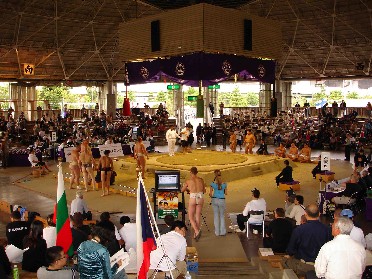
![]()
Amateur Sumo – the sport as it should be
Mark Buckton
Sakai World Sumo Champs – not all about winning
Las Vegas Koen
Joe Kuroda
Our man reports from the fight capital of the world
Rikishi of Old
Joe Kuroda
A look at a rikishi of yesterday with Kotozakura – our man for October
Heya Peek
John Gunning
John’s early morning dash to Azumazeki-beya & report on TKOTU
SFM Interview
Katrina Watts sits down with SFM’s Mark Buckton to discuss amateur sumo
Photo Bonanza
SFM’s best yet – Aki Basho/ Las Vegas / Amateur World Champs / Azumazeki-beya visit – seen nowhere else
Aki Basho Review
Lon Howard
Lon gives us his Aki Basho summary, along with the henka sightings results, and his take on the tournament while ‘gem’ of the basho takes a break
Lower Division Rikishi
Mikko Mattila
Mikko Mattila returns to cover lower division ups and downs
Kyushu Basho Forecast
Pierre Wohlleben & Mark Buckton
Pierre predicts the Kyushu Basho banzuke while Mark previews the ones to watch next time out
Sumo 101
Barbara Ann Klein
Discovers and explains amasumo & ozumo variations
Kimarite Focus
Mikko Mattila
Mikko once again walks us through his chosen kimarite
Minusha
John McTague
John’s unique bimonthly view of news from outside the dohyo
Online Gaming
Zenjimoto of ‘game fame’ covers some of the very best sumo games around – his own!
Kokugi Connections
Todd Lambert
Todd’s focus on 3 of the most interesting online sumo sites today
Fan Debate
Is the limit on foreign rikishi fair? See what our debaters had to say
SFM Cartoons
Benny Loh
In the first of our cartoon bonanzas, sit back and chuckle at Benny Loh’s offerings
Let’s Hear From You
What was it that made you a sumo fan? Gernobono tells all
Readers’ Letters
See what SFM readers had to say since our last issue
Sumo Quiz
The Quizmaster
Answer the Qs and win yourself next basho’s banzuke.
As amateur sumo follows much the same form as the professional ozumo version of the sport with but relatively minor differences (covered here by Barbara Ann Klein in Sumo 101), the amasumo dohyo has proved fertile enough in recent years to produce both Japanese and non-Japanese rikishi who have gone on to enter the professional side of the sport;
Next Home
To that end, seeing Sakai City in southern Osaka, Japan to have hosted just the 13th Sumo World Championships and the 4th Shinsumo World Championships could seem strange, considering the depth of sumo history measured in knee deep calendar pages.
Still, all versions of a competition start somewhere, often growing slowly at first, and under the umbrella of the International Sumo Federation (ISF), the amateur sport of 2005 continues to grow in terms of popularity and participants as the globe wakes up to sumo.

Photo by John Gunning